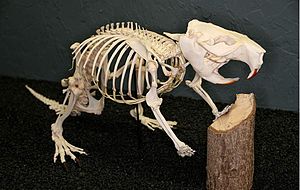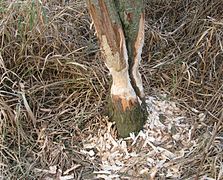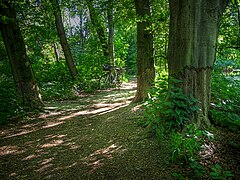beaver
| beaver | ||||||||||||
|---|---|---|---|---|---|---|---|---|---|---|---|---|
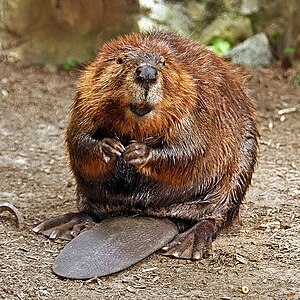
Beaver ( Castor sp.) |
||||||||||||
| Systematics | ||||||||||||
|
||||||||||||
| Scientific name | ||||||||||||
| Castoridae | ||||||||||||
| Hemprich , 1820 |
Beavers (Castoridae) are higher mammals (Eutheria) and belong to the order of rodents (Rodentia). They are the second largest living rodents on earth, after the capybaras .
The family today consists of a single genus , Castor , which is divided into two species : the European beaver ( Castor fiber ), also known as the Eurasian beaver, and the Canadian beaver ( Castor canadensis ). The European beaver is particularly protected in Europe by the Habitats Directive (Annexes II and IV). In Germany he is not subject to hunting law under the Federal Hunting Act .
Some zoologists consider the Canadian beaver to be a subspecies of the European beaver; this view is contradicted by the different number of chromosomes (48 in European, 40 in Canadian). According to Heidecke (1986) , eight subspecies are distinguished.
features
With a total length (including the tail) of 90 to 120 centimeters, the North American beaver reaches a typical body mass of 17 to 32 kilograms (in exceptional cases up to 45 kilograms) and is 10 to 12 years old; Animals in captivity reached the age of 19 years. The European beaver, on the other hand, is slightly smaller and has an average body mass of around 18 kilograms (the heaviest specimen measured weighed 31.7 kilograms).
Eurasian and Canadian beavers are hard to distinguish externally. The genders hardly differ externally either. Only suckling females can be recognized as females by their larger teats; otherwise the cloaca must be scanned for a penis bone . The mostly brown fur of the beaver is very dense with 230 hairs per square millimeter (humans: up to 6) and protects against moisture and cold. The fur is cleaned regularly and cared for with a fatty secretion, the beaver horn (Castoreum).
With its spindle-shaped body, a broad, flattened, hairless tail covered with leather-like skin, called a trowel, and webbed feet , the animal is perfectly adapted to life in the water. The scoop serves as a control when diving as well as for temperature regulation and as a fat deposit. When diving, the nose and ears are closed; beavers can dive for up to 20 minutes.
distribution
The European beaver was originally native to Europe and large parts of Asia , but has then been exterminated in large parts of Europe through hunting (thick fur, edible meat). Through consistent protection and reintroduction in the 20th century, the populations of the European beaver have recovered in the last few decades. For details on distribution see: European beaver .
The Canadian beaver is still widespread in North America. Despite intensive use, the population there was not permanently destroyed. In some cases, the stocks allow beavers to be hunted again (traps). A population of Canadian beavers was created in Finland through the release into the wild. Some Canadian beavers were also released in Austria, but were later intercepted again. For details on distribution see: Canadian beaver .
habitat
The beaver is a semi-aquatic mammal, which means that its habitat is flowing and standing water and its banks. On land he moves slowly due to his clumsy build. His body structure is perfectly adapted to life in and around the water (trowel as steering and driving oar, webbed feet, up to 230 hairs per square millimeter of body surface and 120 hairs per square millimeter on the back, possibility of greasing the fur, sexual organs inside the body, efficient use of the Oxygen, which allows him to dive for up to 20 minutes). The beaver inhabits rivers of all sizes, from first-order rivers to drainage ditches. It can also take on all forms of still waters, from ponds or oxbow lakes to lakes. If there are only inadequate habitats available to it, the beaver is sometimes very adaptable and also settles in unusual places, for example in the middle of towns or directly on highways, where woody plantings are often the most important source of food.
Way of life
Beavers live monogamous . The territory of a beaver family, which consists of the parents and two generations of young animals, comprises 1 to 3 kilometers of running water, depending on the quality of the biotope. The territorial boundaries are marked with Bibergeil , an oily secretion from a gland in the anus area, and defended against intruders.
The old beavers live in the beaver castle with up to four young, often still with young animals from the previous year. In May, the hairy and sighted offspring is born; the previous year’s boys must have left the den before that. The young beavers are initially afraid of water, but are simply thrown into the water by the mother and thus used to life in the water. After being suckled by the mother, usually for two months, they reach sexual maturity after about three years. During this time, their parents drive them out of the area and can then hike over 100 kilometers. The average hiking distance is 25 kilometers. Then they look for a partner and set up a territory themselves.
The beaver is a pure herbivore. He prefers herbs, shrubs, aquatic plants and deciduous trees such as aspens, alders and poplars. From the trees he felled he consumed the twigs, the astringent bark and the leaves. However, it is actually a plant-based omnivore, it also feeds on grasses and reeds.
The beaver is crepuscular and nocturnal. When cutting down he uses an "hourglass technique"; the wood is gnawed in the shape of an hourglass until the tree falls. Depending on the hardness of the wood, a beaver can fell a tree up to 50 centimeters thick in one night.
Beavers do not hibernate , but are also active and foraging in the water and on land in winter. In autumn, the beavers store twigs and branches directly in front of the castle entrance to provide additional food. When the surface of the water is covered with thick ice and the beavers are forced to stay in the castle, they can dive to reach the stored branches and feed on the bark. Mating takes place in winter (January to February).
Beaver structures
The beaver structures consist of residential buildings and beaver dams, some of which are dug into the ground near the bank, some of which are built from building material that has been dragged along: loose (gnawed) branches, twigs, stones, mud and trees felled by the beaver up to a trunk diameter of 80 centimeters.
Residential buildings
In the beaver area there are usually two to four (sometimes up to ten) residential buildings of various shapes. The entrance to the living boiler is always below the water level, the living boiler itself is above water. The living space inside can reach a diameter of up to 120 centimeters and a height of up to 60 centimeters. If the embankment is steep enough, the beaver digs a cave into it and connects it with beaver tubes . These can be feeding tubes, escape tubes and play tubes. If there is a residential building in the beaver dam or in an island-like structure completely surrounded by water and made of suitable building material, it is called a beaver castle . If the residential building falls dry, it will be abandoned because enemies will then have easier access.
Beaver dams
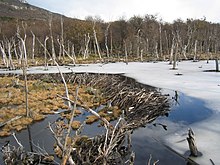
Beavers are known for their dams, which they use to dam streams and even create artificial ponds . The dam primarily helps to ensure a water level above the entrance to the residential building of as much as 60 centimeters and a secure water area around the castle. Beaver dams in flowing waters are threatened with being swept away during heavy rainfall. Beavers can open their dams to allow floods to drain more quickly and thus protect their dams. In this way they regulate the water level of their water area and thus enable even more sensitive aquatic plants to thrive in the pond, which can serve as food for the beaver. Beaver dams require constant expenditure, especially in rivers.
Probably the largest beaver dam in Wood Buffalo National Park in Alberta in northwestern Canada is 850 meters long. According to research by Jean Thie, many generations in decades have worked on this dam.
Natural enemies
Bear , lynx , puma and wolf used to be some of the beaver's most important natural enemies. The most likely danger at the moment is from poaching dogs.
Conflicts with people
Because they cut trees, beavers are particularly unpopular in forestry. Although they mostly use younger trees, some mature trees are also gnawed or felled. If the tree species are important for forestry, the damage can be considerable. Individual trees can be protected with a sleeve made of wire mesh .
The rapidly growing population of the beaver, for example in Mecklenburg-Western Pomerania, poses increasing problems for agriculture and water protection, so that efforts are now being made to limit the protection status of the beaver.
The damming of bodies of water leads to flooding at the edge of the water. Spruce monocultures are sensitive to waterlogging and can die. Dams built by beavers near the street or on underpasses can lead to undercutting.
Sometimes caves are in flood protection dikes created. In the event of flooding, these lead to unstable dykes and, in the worst case, to dyke breakage . The problem can be avoided by taking suitable measures at the endangered areas.
In the summer half of the year, the beaver also uses field crops (sugar beet, corn) near the water. Eating damage in fields has been reported several times.
The beaver is protected according to Annex II and IV of the Habitats Directive .
- Beaver bite damage
Multiple browsing ⊙
In order to defuse the conflict between species protection on the one hand and human interests on the other, some countries rely on targeted beaver management , which includes beaver advisers or carers.
Evolution and systematics
Internal system
|
Internal systematics of beavers according to Samuels et al. 2009
|
The beavers form a family within the rodent order . It is with Castor only one genus in the Northern Hemisphere widely. The origin of the beaver goes back to the end of the Eocene . In the course of the tribal history , numerous forms developed that corresponded to around 30 genera. The most original group is the subfamily of Agnotocastorinae , whose members still share numerous characteristics with their predecessors, which can be found in the Eutypomyidae , which are found mainly in North America . The other beaver representatives can in principle be divided into two groups: a semi-aquatic group and a terrestrial burrowing group adapted to open landscapes. The first includes the subfamilies of the Castorinae , to which Castor also belongs, and the Castoroidinae , which include the better-known genera Castoroides (giant beaver) and Trogontherium (old beaver). They also represent a younger member of the phylogenetic history of the beaver. The second group consists of the subfamilies of the Palaeocastorinae and the Migmacastorinae , which are restricted to the Oligocene and Miocene . It was created due to the cooling climatic conditions in the course of the Oligocene and the associated spread of the grasses. However, it probably died out again in the Miocene due to competition from other similarly adapted mammals. The most important representatives include Palaeocastor and Migmacastor . According to phylogenetic studies, both the semi-aquatic adapted and the terrestrial-subterranean group each form a monophyletic unit. In today's beavers, however, a partially digging activity is also known, just as some extinct, primarily semi-aquatic forms, such as steneofibers or nothodipoides , show adaptations to digging in their skeletal features. It can therefore be assumed that the common ancestor of the two groups already possessed these characteristics. The characteristic gnawing of trees known from today's beavers is, however, a derived feature of the semi-aquatic group. It only developed within this group in Castor and Dipoides . The latter form is closely related to the old and giant beaver and, according to isotope analyzes , used this ability not to build dams, but primarily to eat. According to molecular genetic analyzes, the semi-aquatic line of beavers has existed since the Lower Miocene. The Castorinae and the Castoroidinae separated accordingly around 19.7 million years ago.
Two species of the genus Castor have recently been distinguished, the European and the Canadian beaver. The Canadian beaver can be clearly distinguished from the European beaver by its lower number of chromosomes (40 C. canadensis , 48 C. fiber ). According to genetic studies, both species have been forming separate lines since the Upper Miocene around 7.7 million years ago. According to some experts, the description of various subspecies in the European beaver is a result of the islanding after this species was in the 19th / 20th Century was already strongly decimated.
- European beaver ( Castor fiber Linnaeus, 1758)
- Canadian beaver ( Castor canadensis Kuhl, 1820)
Tribal history
One of the most important and most frequently found early beaver forms is Palaeocastor , who inhabited the open steppe landscapes of western North America in the Upper Oligocene and Lower Miocene around 30 to 20 million years ago . It is the type genus of the Palaeocastorinae and was a small representative with a maximum body weight of 4 kilograms. Its skeleton showed numerous features for a burrowing way of life, with the Biberg genus mainly using their incisors. Palaeocastor left behind complex burial tunnels, which have been handed down mainly in the Harrison Formation in Nebraska and Wyoming and which are characterized by a spiraling corridor leading into the underground. Because of this striking shape, the burial tunnels are known as daimonelix ("devil's corkscrew").
Two important beaver representatives of the Pleistocene belong to the group of Castoroidinae . The giant beaver ( Castoroides ohioensis ) lived in North America for the last two million years and grew up to 250 centimeters. The most recent finds are around 10,000 years old, so humans may have come across this beaver. The ancestors of the giant beaver are species of the genus Dipoides (about 5 million years old) and Procastoroides (somewhat younger). The genus Trogontherium , which was native to Eurasia , probably also belongs to this lineage. This species of beaver, also known as the old beaver, was longer than the recent European beaver, but significantly slimmer and with a stronger lower jaw. The lower limb sections were longer, while the upper sections were shorter, which enabled him to live a more agile way of life with probably better swimming skills. Trogontherium already appeared in the Upper Miocene and is known in the Upper Pliocene from sites such as Tegelen ( Netherlands ) and Mosbach (in the urban area of Wiesbaden , Hesse ). In younger Middle Pleistocene these Biberart died out. The most recent finds include those from Bilzingsleben ( Thuringia ) and Schöningen ( Lower Saxony ). A relatively complete skeleton was recovered from the latter location in 2003.
The origin of today's beavers may already be in the Miocene. At this time, Sinocastor appears in China and Mongolia, which is very closely related to Castor due to the shape of the skull . This could possibly indicate an Asian origin of the beaver. The earliest evidence of a modern beaver in North America also dates to the late Miocene around 7 million years ago, but only includes a few molars. Modern beavers are found to be fossilized quite frequently. In Europe, the European beaver occurs sympathetically with the old beaver at the important sites in Bilzingsleben and Schöningen .
Cultural aspects
- Architecture: The catchy shape of the beaver's tail gave its name to one type of roof tile .
- Diet: beaver meat fried or steamed, especially beaver tail as a fasting food , because it is not regarded as meat but as the "fishy" part of the beaver (movement in water). In the Council of Constance of 1414/18 it was decided “beavers, badgers, otters - everything is enough” and finally the Jesuit Father Charlevoix declared in 1754 : “As far as the tail is concerned, it is completely fish, and it has been declared as such by the medical faculty in Paris and in the wake of this declaration, the Faculty of Theology decided that meat may be eaten during Lent. ” Beavertail is a popular sweet in Canada. It is a warm, fat pastry sprinkled with cinnamon sugar in the form of a beaver tail, the method of preparation is comparable to our donuts .
- Literature: The beaver fur ; thieving comedy by Gerhart Hauptmann . In some fables , the beaver is called Master Bockert . In Lewis Carroll's ballad The Hunting of the Snark (German / English in the Insel-Bücherei 934), a clapper beaver belongs to the otherwise only human-occupied snark hunting party.
- Movie: The Angry Beavers (Engl. The Angry Beavers ); Animated series about two beaver brothers who experience all sorts of bizarre adventures as bachelors. The comedy Zombiber parodies horror films by portraying peaceful, herbivorous animals as zombies .
- Clothing: The beaver hair is processed into hats (cf. castor hat ), the beaver fur into fur clothing, especially collar trimmings.
- Naming / heraldry: the animal beaver is usually the namesake of the numerous beaver places and rivers / streams in Germany. These names are mostly of Celtic origin and are derived from the Celtic word bior , or the Low German bever (see Bieber and the coat of arms of Westbevern in the Münsterland.)
- Advertising: mascot of a hardware store chain (association of building dams , construction , Do It Yourself , hard work , hobbyist ) as well as for a (children's) toothpaste (association: incisors , food , livelihood , toothpaste, dental care ); short comic strips on cardboard packaging are intended to encourage brushing teeth.
- Symbolism: Because of the widespread fur trade, the beaver plays a certain role in North America as an emblem and heraldic animal. It is the "national animal" of Canada as well as the states of New York and Oregon . Because of its "building activity" and its reputation for being a particularly hard-working animal, the beaver is widely used as a university mascot - primarily in the Anglo-Saxon region - by the Massachusetts Institute of Technology , the California Institute of Technology , the Oregon State University and the London School of Economics and Political Science .
See also
literature
- Wadim W. Djoshkin, Vladimir G. Safonow: The beavers of the old and the new world. (= Die Neue Brehm-Bücherei. Volume 437). A. Ziemsen Verlag, Wittenberg Lutherstadt 1972, ISSN 0138-1423 .
- Dietrich Dolch, Dietrich Heidecke, Jana Teubner, Jens Teubner: The beaver in the state of Brandenburg. In: Nature conservation and landscape maintenance in Brandenburg. Vol. 11, No. 4, 2002, ISSN 0942-9328 , pp. 220-234.
- D. Heidecke: Taxonomic aspects of species protection using the example of Eurasian beavers. In: Hercynia. NF Vol. 22, No. 2, 1986, ISSN 0018-0637 , pp. 146-161.
- Gustav Hinze: Our beaver. (= Die Neue Brehm-Bücherei. Volume 111). 3rd, unchanged edition, reprint of the 2nd edition from 1960. Westarp-Wissenschaften-Verlags-Gesellschaft, Hohenwarsleben 2003, ISBN 3-89432-489-9 .
- Lewis Henry Morgan : The American beaver and his works. Lippincott, Philadelphia PA 1868, facsimile .
- Gerhard Schwab, Markus Schmidbauer: Beaver (Castor fiber L., Castoridae) management in Bavaria. In: Denisia. Vol. 9, 2003, ISSN 1608-8700 , pp. 99-106, online (PDF; 727 kB) .
- Gerhard Schwab u. a .: Beaver in Bavaria: Biology and Management / Bavarian State Office for the Environment. Bavarian State Office for the Environment LfU, Augsburg 2009, ISBN 978-3-940009-20-3 .
- Meinolf Schumacher : The beaver - an ascetic? A metaphorical motif from fable and “Physiologus”. In: Euphorion. Vol. 86, 1992, ISSN 0014-2328 , pp. 347-353.
- Hubert Weinzierl : Beaver: Builder of the wilderness. Bund Naturschutz Service GmbH., Lauf an der Pegnitz 2003, ISBN 3-9808986-0-1 .
- Volker Zahner, Markus Schmidbauer, Gerhard Schwab: The beaver. The return of the lords of the castle. Buch- und Kunstverlag Oberpfalz, Amberg 2005, ISBN 3-935719-32-9 .
- Barbara Petersen et al .: The European system of protected areas Natura 2000. Ecology and distribution of species of the Habitats Directive in Germany. Volume 2: Vertebrates (= series of publications for landscape management and nature conservation. Issue 69, Vol. 2). Federal Agency for Nature Conservation, Bonn - Bad Godesberg 2004, ISBN 3-7843-3620-5 . - The Federal Agency for Nature Conservation (BfN) published two specialist books in February 2005 to help deal with the species of the Habitats Directive in Germany. For the first time, it presented the relevant basic data for FFH species, which are required for the implementation of the European directive, e.g. B. in questions of planning, reporting obligations and environmental impact assessments . The work presents in detail all of the species native to Germany that fall under the Habitats Directive - including the beaver. Call tables
- the scientific and German species name with EU code,
- Information on the systematics / taxonomy , the species-specific characteristics, the distribution of the species and Germany's responsibility for the conservation of the respective species in the EU.
- the essential data on biology and ecology, risk and protection as well as
- Further information on the identification of the species, the need for research and species experts .
Web links
- Does the beaver have to die? Dispute over an exotic species on Tierra del Fuego - Ethics discussion using the example of the beaver
- Friend beaver, better than his reputation
- Eurasian beaver
- The beaver castle - the website about the beaver
- waldwissen.net : The beaver - landscape designer with potential for conflict
- Beaver - master builder of the wilderness (Bavarian State Office for the Environment) (PDF; 1.1 MB)
- spurenjagd.de - website with data collection on beaver tracks
- Beaver - Information from the Federal Office for the Environment
Individual evidence
- ↑ Beaver: from Old High German bibar , "brown brown", dark brown animal, beaver; Reduplication to bër , brown, and like Latin fiber from Indo-European bher (o) , brown. Cf. Friedrich Kluge , Alfred Götze : Etymological dictionary of the German language . 20th ed., Ed. by Walther Mitzka , De Gruyter, Berlin / New York 1967; Reprint (“21st unchanged edition”) ibid 1975, ISBN 3-11-005709-3 , p. 73 f.
- ↑ Beaver in the Encyclopædia Britannica.
- ↑ Council Directive 92/43 / EEC of May 21, 1992 on the conservation of natural habitats and wild animals and plants , accessed on August 26, 2018 . In: EUR-Lex .
- ↑ North American beaver (PDF; 39 kB) on Alaska.gov.
- ↑ Andrew Kitchener: Beavers. Whittet, London 2001, ISBN 1-873580-55-X , p. 144.
- ↑ Gerold Stocker: Beaver (Castor fiber L.) in Switzerland (PDF; 13.6 MB). Federal Institute for Forest Research, August 1985. P. 12. Stocker refers to: Richard, PB, 1962: Détermination du sexe du castor vivant (Castor fiber).
- ↑ Andreas Krebs: The beavers are back. In: Of course . Issue 1/2007, accessed on January 17, 2014 (PDF).
- ↑ a b Gerhard Schwab: Biology of the beaver. Seminar manuscript 2004 PDF file .
- ↑ ORF Science: Huge beaver dam via space discovered on May 12, 2010, seen on October 25, 2015; ORF article contains URL to Jean Thie and the original Los Angeles Times article
- ↑ Huge beaver dam can be seen from earth orbit
- ↑ Petition 69382 Species protection - inclusion of the beaver in Appendix V of the Habitats Directive of 10.01.2017. In: petition. German Bundestag, accessed on March 19, 2017 .
- ↑ Annex II Habitats Directive www.ffh-gebiete.de accessed in October 2012
- ↑ Annex IV and V of the Habitats Directive www.ffh-gebiete.de accessed in October 2012.
- ^ A b Joshua X. Samuels and Blaire Van Valkenburgh: Craniodental Adaptations for Digging in Extinct Burrowing Beavers. Journal of Vertebrate Paleontology 29 (1), 2009, pp. 254-268.
- ↑ Marguerite Hugueney and François Escuillié: Fossil Evidence for the Origin of Behavioral Strategies in Early Miocene Castoridae, and Their Role in the Evolution of the Family. Paleobiology 22 (4), 1996, pp. 507-513.
- ^ William W. Korth: The skull of Nothodipoides (Castoridae, Rodentia) and the occurrence of fossorial adaptions in beavers. Journal of Paleontology 81 (6), 20078, pp. 1533-1537.
- ^ William W. Korth: Comments on the Systematics and Classification of the Beavers (Rodentia, Castoridae). Journal of Mammalian Evolution 8 (4), 2001, pp. 279-296.
- ^ Natalia Rybczynski: Castorid Phylogenetics: Implications for the Evolution of Swimming and Tree-Exploitation in Beavers. Journal of Mammalian Evolution 14, 2007, pp. 1-35.
- ^ A b Natalia Rybczynski, Elizabeth M. Ross, Joshua X. Samuels and William W. Korth: Re-Evaluation of Sinocastor (Rodentia: Castoridae) with Implications on the Origin of Modern Beavers. Plos ONE 5 (11), 2010, p. E13990, doi: 10.1371 / journal.pone.0013990 .
- ↑ Tessa Plint, Fred J. Longstafe, Ashley Ballantyne, Alice Telka and Natalia Rybczynski: Evolution of woodcutting behavior in early pliocene beaver driven by consumption of woody plants. Scientific Reports 10, 2020, p. 13111, doi: 10.1038 / s41598-020-70164-1 .
- ↑ a b Georgios Xenikoudakis, Mayeesha Ahmed, Jacob Colt Harris, Rachel Wadleigh, Johanna LA Paijmans, Stefanie Hartmann, Axel Barlow, Heather Lerner and Michael Hofreiter: Ancient DNA reveals twenty million years of aquatic life in beavers. Current Biology 30, 2020, pp. R110 – R111, doi: 10.1016 / j.cub.2019.12.041 .
- ↑ Larry D. Martin and Debra K. Bennett: The burrows of the Miocene beaver Palaeocastor, Western Nebraska, USA Palaeogeography, Palaeoclimatology, Palacoecology 22, 1977, pp. 173-193.
- ^ A b Karlheinz Fischer: Postcranial skeletal elements of beavers (Castor L., Trogontherium Fischer, Castoridae, Rodentia, Mamm.) From the Middle Pleistocene from Bilzingsleben. In: Karlheinz Fischer, Ekke E. Guenther, Wolf-Dieter Heinrich, Dietrich Maniaudolf Musil, Tiko Nötzold (eds.): Bilzingsleben. Homo erectus - his culture and his environment (= publications of the State Office for Archeology, State Museum for Prehistory Saxony-Anhalt. Vol. 44), Volume 4, Deutscher Verlag der Wissenschaften, Berlin 1991, ISBN 3-326-00660-8 , p. 63-70.
- ↑ DA Apoltsev and LI Rekovets: Beavers of the genus Trogontherium (Castoridae, Rodentia) from the Late Miocene of Ukraine. Vestnik zoologii 49 (6), 2015, pp. 419-528, doi: 10.1515 / vzoo-2015-0062 .
- ↑ Wolf-Dieter Heinrich and Thijs van Kolfschoten: First skeleton find of a Trogontherium cuvieri (old beaver). In: Hartmut Thieme (Ed.): The Schöninger Speere. Humans and hunting 400,000 years ago. Theiss u. a., Stuttgart 2007, ISBN 978-3-89646-040-0 , pp. 118-123.
- ↑ Joshua X. Samuels and John Zancanella: An Early Hemphillian Occurrence of Castor (Castoridae) from the Rattlesnake Formation of Oregon. Journal of Paleontology 85 (5), 2011, pp. 930-935.
- ^ Thijs van Kolfschoten: The small mammal finds from the Reinsdorf interglacial of Schöningen. In: Hartmut Thieme (Ed.): The Schöninger Speere. Humans and hunting 400,000 years ago. Theiss u. a., Stuttgart 2007, ISBN 978-3-89646-040-0 , pp. 112-117.

